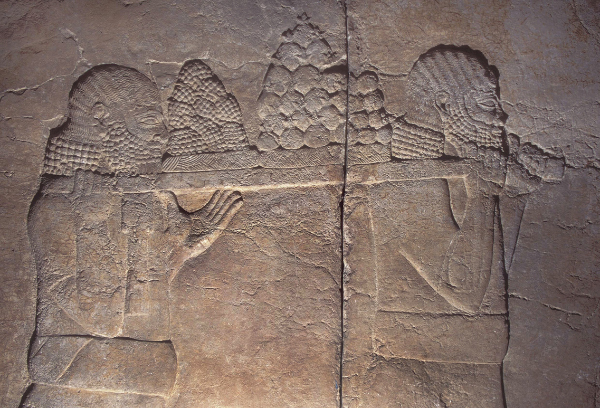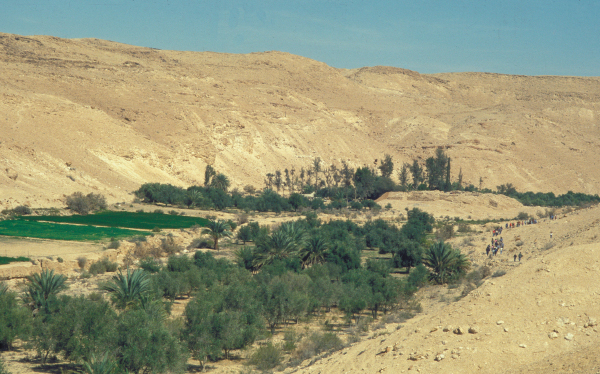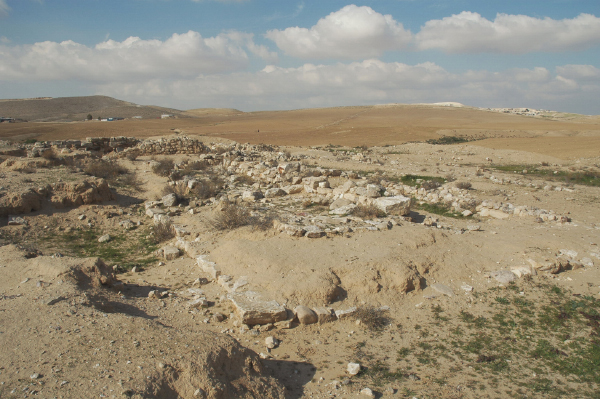Fourth Rebellion: Rejection of the Land (13:1—14:45)
Grapes (13:20). This is the time of the first harvest of the vineyards, hence late summer or early fall, several months after the departure from Mount Sinai in early spring.103
Desert of Zin as far as Rehob, toward Lebo Hamath (13:21). The twelve Israelite men launched their exploration of the land from the Paran Desert. The Desert of Zin was the region of the drainage basin around the Nahal Zin, an expanse westward on a line from just south of the Dead Sea that includes the wilderness, as well as Kadesh Barnea to the west (v. 26). They reached as far north as Rehob of Lebo Hamath in southeast Lebanon. The exact location of this Rehob is unknown, though the region of Lebo Hamath suggests a site in southern Lebanon, such as Beth Rehob near Tel Dan on the southern flank of Mount Hermon.104
Lebo Hamath has been identified with modern Lebweh on the Orontes River, on the southern border of the ancient kingdom of Hamath and about fourteen miles north-northeast of Baalbek. Lebo is recounted as a city on the northern border of the Promised Land (Num. 34:7–8) and later of the Israelite kingdom of David and Solomon (1 Kings 8:65).

Desert of Zin
Jack Hazut
Negev (13:22). The scouts headed north through the hill country regions later known as Judah, Samaria, and Galilee, starting in the Negev (“southland”). In the Old Testament, the Negev region stretched south from Hebron (Qiryath ʿArba) into the Desert of Zin (e.g., Gen. 12:9; 13:3, 14; 20:1; 24:62; Num. 21:1; 33:40); in modern geography the term denotes the region from the Arad and Beersheba region south to Elat on the Gulf of Aqaba.
Hebron . . . Zoan in Egypt (13:22). Hebron, formerly known as Qiryath ʿArba, is located about twenty miles south of Jerusalem in the central hill country. It must have been a prominent city at this time because of its comparison with the Egyptian stronghold of Zoan. The ancestry of the Hebronites is highlighted by the mention of three clans of the Anakites, namely Ahiman, Sheshai, and Talmai. These names are Semitic in origin, reflecting the fact that the inhabitants of the land spoke a Semitic dialect.
The name “Anak” is associated with a people feared for their great size and military prowess; it may also be associated with the ethnic phrase Iy-ʿanaq found among the Egyptian Execration Texts of the early second millennium B.C.105 The LXX of verse 33 translates the term as “giants,” and they were associated with the Rephaim in Deut. 2:11 (cf. also 9:2). Remnants of these giants survived into the time of the Judges and the beginning of the Israelite monarchy.
Hebron was said to have been fortified seven years before Zoan, which was in the eastern Nile Delta. This name is the equivalent of the Egyptian Djaʿnet, which was vocalized by the Greeks as Tanis, long identified with the modern site of San el-Hagar. Early excavators thought this was the site of the city of Ramesses mentioned in Exodus 1, but it is now known that Pi-Ramesses is located at Tel ed-Dabʿa (= Avaris/Qantir), twelve miles south of Zoan/Tanis.106 Earliest indicators suggest that Zoan was founded in the twelfth century B.C. .

Hebron (Tel Rumeida)
Z. Radovan/www.BibleLandPictures.com
Forty days (13:25). The scouts’ forty-day exploration of the land accords with the approximate time such a journey would have taken on foot. The number forty is often used in the Bible for an indefinite period in excess of a month. Having trekked from the Desert of Zin all the way to Lebo Hamath and back again means they would have covered from 350 to 500 miles while reconnoitering the hill country and valleys. According to the annals of the campaigns of Thutmose III and Ramesses II, a day’s journey was approximately twelve to fifteen miles.
Kadesh in the Desert of Paran (13:26). Kadesh (Barnea) is usually identified with ʿAin el-Qudeirat in the upper reaches of the Desert of Zin, about fifty miles southwest of Beersheba. The springs produce a volume of about forty cubic meters of water per hour (there are no fortifications from the Late Bronze Age or Iron I periods there). Pottery remains suggest this spring area was often the stopping point for nomadic groups since the late Neolithic period through the Bronze Ages.107 An Israelite fortress was constructed there in the tenth century B.C. and destroyed by the Babylonians in 586 B.C. The spies’ report concludes with a listing of the various Semitic and non-Semitic tribes living throughout the country.

Fruit-bearers on Assyrian relief
Z. Radovan/www.BibleLandPictures.com

Kadesh Barnea region
Z. Radovan/www.BibleLandPictures.com
Milk and honey (13:27). This classic description of the abundance of natural flora and fauna of Canaan (e.g., Ex. 3:8, 17; 13:5; 33:3; Lev. 20:24; Deut. 6:3; 11:9) is echoed in the Egyptian travel account The Story of Sinuhe, where the princely emissary describes the land of Yaa.
Amalekites (13:29). The Amalekites were a seminomadic tribe whose origins were in the region of Edom and who ranged throughout the southern Levant, from northern Sinai to the hill country of Samaria. Hormah (Tel Masos in the Negeb) may have been one of their cities (Num. 14:45; cf. Gen. 36:16; Judg. 12:15; 1 Sam. 15:7).108 No reference is found to the Amalekites in ancient Near Eastern documents.
Hittites (13:29). Among the numerous ethnic inhabitants of the central highlands were clans of the Hittites, such as are known from the patriarchal period (Gen. 23:3–20). Their origins in eastern Anatolia dating to the third millennium B.C. are well known from historical and archaeological records.109 The Hittite empire flourished in the Late Bronze Age (1550–1200 B.C.), centered in Hattušas, and extended from central Anatolia to the upper Euphrates and to the northern Levant.
Jebusites (13:29). The Jebusites were a non-Semitic clan who lived in Jerusalem during the Middle Bronze through Iron I periods (2000–1000 B.C.); they controlled the city through most of the early history of Israel until the time of David (see Josh. 15:8, 63; 18:16; Judg. 1:8, 21; 2 Sam. 5:6–9). They are unknown outside the Bible, and scholars have suggested they may have been a subclan of the Perizzites or related to the Hurrians.110 The Table of Nations lists the Jebusites as descendants of Canaan (Gen. 10:16).
Amorites (13:29). The term “Amorite” can refer in general to a number of the inhabitants of the Levant, including areas known today as Syria, Lebanon, Jordan, Israel, and Palestine. It may also refer more specifically to an ethnic descendant of Canaan as delineated in Genesis 10:16.111 Referred to as the Amurru (“Amorites” or “westerners”) in Akkadian records at Mari and the Martu in Sumerian texts of the third and second millennia B.C., some of this people group established city-states in Syria while others were more nomadic, migrating southeast into southern Sumer and southwest into the Levant. Egyptian records describe their territory as extending from the Negev to the heights of Lebanon.

Faience tiles portraying various people groups from the Levant
Z. Radovan/www.BibleLandPictures.com
Canaanites (13:29). During much of the Late Bronze Age, the land of Canaan was controlled by Egypt under the Eighteenth and Nineteenth Dynasties (see introduction), as reflected in the temple texts of Thutmose I, Thutmose III, Amenhotep II, the Amarna Letters of the fourteenth century B.C., and the texts of Ramesses II.112 The region extended along the Mediterranean Sea from the Wadi el-ʿArish to Lebo Hamath in Lebanon, and inland to the Jordan Valley region. The inhabitants of Canaan included numerous ethnic subgroups. The designation of “Canaan” may derive from the Akkadian kinannu (“red purple”), based on the production of red-to-purple dyes produced along coastal regions of Lebanon from the abundant murex shells found there. Other scholars point to the Semitic root k-n-ʿ meaning “to bend, be subdued.” The earliest reference to “Canaan” comes from the eighteenth century B.C. in Mari.113
Nephilim (13:33). Referring to the descendants of Anak as Nephilim was designed to instill fear in the hearts of the Israelites in the face of their enemies, to make them feel like grasshoppers. Grasshoppers were the smallest of edible creatures permitted for Israelite consumption (Lev. 11:22). The Nephilim (“fallen ones”; “giants” in the LXX) are noted in Genesis 6:4 as the product of the “sons of God” (“angelic beings” or “divine warriors”) and the “daughters of men.”
Tore their clothes (14:6). Tearing one’s clothes was a form of self-debasing lament in the Old Testament; it was widely practiced in the ancient Near East in mourning for the dead, in expressing sorrow over disease or plague, or in prefacing a prophetic lament of judgment against an individual or nation.114 In the Tale of Aqhat from Ugarit, Paghat (daughter of Daniʾilu) laments the coming drought that has been foretold:
Paghat weeps in her heart, cries in her inward parts
She rends the garment of Daniʾilu the man of Rapaʾu
The cloak of the valiant man of Harnam. . . .115
Route to the Red Sea (14:25). The “Way of the Red Sea Wilderness” was the trade route connecting to Ezion Geber on the Gulf of Aqaba/Elath from Kadesh Barnea through the Desert of Zin and the southern Arabah. A second leg of the route then extended westward across the central Sinai peninsula toward Egypt.
Hormah (14:45). Hormah has been identified tentatively with Tel Masos in the Beersheba Valley region, though other sites have also been suggested.116 Hormah is mentioned in the Middle Bronze Age Egyptian sources, including the Execration Texts and an inscription in a Sinai mine dated to the reign of Amenemhet III (1831–1786 B.C.).117

Tell Masos
Todd Bolen/www.BiblePlaces.com